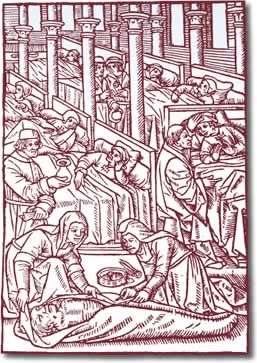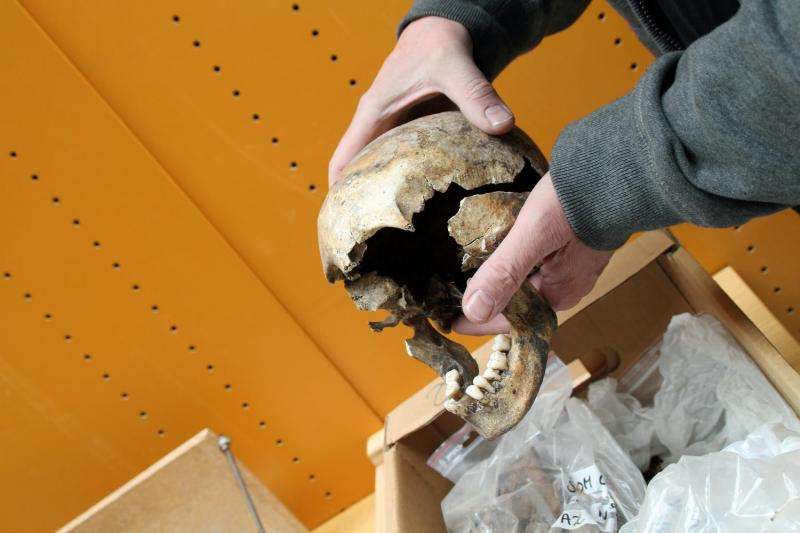Being rich in the Middle Ages led to an unhealthy life

In the Middle Ages only wealthy town people could afford to eat and drink from beautiful, colored glazed cups and plates. But the glazing was made of lead, which found its way into the body if you ate acidic foods. This has been revealed by chemical investigations of skeletons from cemeteries in Denmark and Germany.
Being wealthy in the Middle Ages was not all benefits: Wealthy people were more exposed to the toxic heavy metal lead than the poor.
"Lead poisoning can be the consequence when ingesting lead, which is a heavy metal. In the Middle Ages you could almost not avoid ingesting lead, if you were wealthy or living in an urban environment. But what is perhaps more severe, is the fact that exposure to lead leads to lower intelligence of children", says Associate Professor Kaare Lund Rasmussen, Department of Physics and Chemistry, University of Southern Denmark (SDU).
Together with colleagues Rasmussen has published a series of chemical and anthropological analyzes of 207 skeletons from six cemeteries in northern Germany and Denmark. The paper is published in the Journal of Archaeological Science: Reports. The work was performed in collaboration with other SDU scientists: Professor Jesper Lie Boldsen from the Institute of Forensic Medicine and postdoc Lilian Skytte and Ph.D. student Anne Juul Jensen from the research group CHART at Department of Physics, Chemistry and Pharmacy.
Practical, beautiful—and poisonous
"There really is a big difference in how much lead, the individuals from the cemeteries had in their bodies. This depended on whether they lived in the country or in a town. We see almost no lead in the bones from rural individuals, while the levels of this toxic metal were high in urban individuals", says Rasmussen.
In the Middle Ages wealthy Danes and Germans mainly lived in towns, while the rural population was generally poorer and more isolated. The wealthy could afford to eat and drink of glazed pottery, and this was the main source of lead poisoning.
"In those days lead oxide was used to glaze pottery. It was practical to clean the plates and looked beautiful, so it was understandably in high demand. But when they kept salty and acidic foods in glazed pots, the surface of the glaze would dissolve and the lead would leak into the food", says Rasmussen.

In the country, glazed pottery was seemingly used more rarely. And even if you had the money, it would have been more difficult to get by. Instead, the country people used unglazed pottery and thus unknowingly saved themselves from exposure to the toxic lead.
Glazed pottery was not the only source of lead in the towns. Lead was also present in coins, stained glass windows and lead tiles on the roofs of important buildings. Drinkingwater was often collected from the roof, and this may also have been an important source of lead.

Rasmussen studied skeletons from six cemeteries.
The cemeteries in Rathaus Markt in Schleswig (Germany) and Ole Worms Gade in Horsens (Denmark) are both situated on the coast and people buried here were from medieval towns that were more wealthy and more in contact with the outside world than most rural population.
The rural population was represented by cemeteries in St. Clements outside of Schleswig (Germany), Tirup outside of Horsens (Denmark), Nybøl in Jutland (Denmark) and St. Alberts Chapel on the island of Ærø (Denmark).
"The exposure was higher and more dangerous in the urban communities, but lead was not completely unknown in the country. We saw that 30 pct. of the rural individuals had been in contact with lead—although much less than the townspeople."

There were different levels of exposure in the towns. 19 pct. (10 individuals) from the cemetery in Rathaus Markt had lead levels above normal. In Horsens all 25 individuals had levels above normal.
Mercury was given as medicine
The research team also tested the skeletons for their content of mercury. Mercury was used to prepare the color cinnabar, for gilding and as medicine against leprosy and syphilis.
The results of the measurements show that the urban population was more exposed to mercury than the rural population. Mercury was administered to treat especially leprosy, which almost half of the individuals in the study suffered from.
However the study reveals a difference in how effective the treatment was in the towns.
"Maybe they had more expertise in mercury treatments in Schleswig than in Horsens", says Rasmussen.
More information: Journal of Archaeological Science: Reports,Vol 3, September 2015, Pages 358–370: Comparison of mercury and lead levels in the bones of rural and urban populations in Southern Denmark and Northern Germany during the Middle Ages. www.sciencedirect.com/science/journal/2352409X
Journal information: Journal of Archaeological Science
Provided by University of Southern Denmark



















